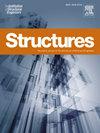Study on the optimal thickness ratio of steel-aramid composite structure against local explosion
IF 3.9
2区 工程技术
Q1 ENGINEERING, CIVIL
引用次数: 0
Abstract
Previous studies of the steel-aramid anti-explosion structure have not dealt with the optimal thickness ratio of the steel and the aramid layers. In this paper, the damage mechanism of aramid-steel composite (ASCTs) target plate with single layer and multiple structural configurations under local explosion load is studied by experimental and numerical simulation methods. The influence of different thickness combinations on the anti-explosion performance of aramid composite structure was compared, and the thickness combination mode with the best cost performance was analyzed. The optimal structure anti-explosion design scheme was obtained by using the optimization method. The optimal thickness ratio has been analyzed, and the optimal anti-explosion structure design has been given. Experimental results show that at the same proportional blast distance (200 g TNT), the Q235 steel-aramid laminate target suffered no structural failure and its centre deflection was 10 % less than single-layer steel (S-1). The same thickness steel sheet (S-2) without the aramid laminate failed to perform as expected. The numerical simulation results show that at a proportional blast distance of 0.16 m/kg1/3, the best blast protection thickness ratio of the Q235 steel-aramid protective structure is 2.6:9.
钢-芳纶复合结构抗局部爆炸最佳厚度比研究
以往对钢-芳纶防爆结构的研究并未涉及钢层和芳纶层的最佳厚度比。本文通过实验和数值模拟方法,研究了单层和多层结构配置的芳纶-钢复合材料(ASCTs)靶板在局部爆炸载荷作用下的破坏机理。比较了不同厚度组合对芳纶复合材料结构抗爆性能的影响,分析了性价比最优的厚度组合模式。利用优化方法获得了最优结构防爆设计方案。分析了最佳厚度比,给出了最优防爆结构设计方案。实验结果表明,在相同比例的爆炸距离(200 克 TNT)下,Q235 钢-芳纶层压板靶没有发生结构破坏,其中心挠度比单层钢板(S-1)小 10%。而没有芳纶层压板的同厚度钢板(S-2)则未能达到预期效果。数值模拟结果表明,在 0.16 m/kg1/3 的比例爆炸距离下,Q235 钢-芳纶防护结构的最佳防爆厚度比为 2.6:9。
本文章由计算机程序翻译,如有差异,请以英文原文为准。
求助全文
约1分钟内获得全文
求助全文
来源期刊

Structures
Engineering-Architecture
CiteScore
5.70
自引率
17.10%
发文量
1187
期刊介绍:
Structures aims to publish internationally-leading research across the full breadth of structural engineering. Papers for Structures are particularly welcome in which high-quality research will benefit from wide readership of academics and practitioners such that not only high citation rates but also tangible industrial-related pathways to impact are achieved.
 求助内容:
求助内容: 应助结果提醒方式:
应助结果提醒方式:


